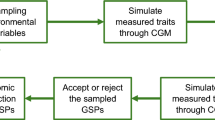Summary
The International Spring Wheat Yield Nursery (ISWYN) has been distributed annually since 1964 and the results provide a base for investigating relationships among locations. Ordination and clustering of locations was conducted using 26 years of grain yield data. Ordination and clusters based on the discrimination of germplasm were compared with ‘mega-environments’, which are groupings of locations defined by CIMMYT on the basis of climatic factors and perceptions of major biotic and abiotic stresses. Discrepancies among mega-environmental groupings, clusters and ordinations may identify locations for which major stresses affecting wheat yield are yet unidentified.
Major environmental discriminators were latitude and the presence or absence of stress, although there was little association of locations due to limited moisture availability. We identified two major spring wheat environments, typified as Asian and European, and suggest the mega-environmental classification does not explain all significant associations among locations. Location groupings based on discrimination of germplasm should be considered in parallel to mega-environments on a regular basis and we propose breeding for a base of broadly adapted germplasm to which specific stress tolerances are incorporated.
Similar content being viewed by others
Abbreviations
- CIMMYT:
-
International Maize & Wheat Improvement Centre
- ISWYN:
-
International Spring Wheat Yield Nursery
- WANA:
-
West Asia and North Africa
References
CIMMYT, 1968. Research bulletin no. 11. Results of the second International Spring Wheat Yield Nursery (ISWYN) 1965–66. CIMMYT, Mexico, D.F.
CIMMYT, 1989. Towards the 21st century: CIMMYTs strategy. CIMMYT, Mexico. D.F.
Braun H.-J., W.H. Pfeiffer & W.G. Pollmer, 1992. Environments for selecting widely adapted spring wheat. Crop Sci. 32: 1420–1427.
Burr E.J., 1968. Cluster sorting with mixed character types. I. Standardization of character values. Aust. Comp. J. 1: 97–99.
Burr E.J., 1970. Cluster sorting with mixed character types. II. Fusion strategies. Aust. Comp. J. 2: 98–103.
Byth D.E., R.L. Eisemann & I.H. DeLacy, 1976. Two-way pattern analysis of a large data set to evaluate genotypic adaptation. Heredity 37: 215–230.
DeLacy I.H. & M. Cooper, 1990. Pattern analysis for the analysis of regional variety trials. p. 301–334. In: M.S. Kang (Ed). Genotype-By-Environment Interaction and Plant Breeding. Lousiana State University, Baton Rouge, Lousiana 70803 (12–13 February).
DeLacy I.H. & P. Lawrence, 1988. Combining pattern analyses over years — Classification of locations. p. 175–176. In: K.S. McWhirter, R.W. Downes & B.J. Read (Eds). Proc. of the Ninth Australian Plant Breeding Conference. Organising Committee, Wagga Wagga, Australia (17 June–1 July).
DeLacy I.H., M. Cooper & P. Lawrence, 1990. Pattern analysis over years of regional variety trials: Relationship among sites. p. 189–213. In: M.S. Kang (Ed). Genotype-By-Environment Interaction and Plant Breeding. Louisana State University, Baton Rouge, Lousiana 70803 (12–13 February).
Fox P.N. & A.A. Rosielle, 1982. Reducing the influence of environmental main-effects on pattern analysis of plant breeding environments. Euphytica 31: 645–656.
Gower J.C., 1966. Some distance properties of latent root and vector methods used in multivariate analysis. Biometrika 53: 325–338.
Gower J.C., 1967. Multivariate analysis and multidimensional geometry. The Statistician 17: 13–28.
Peterson C.J., 1992. Similarities among test sites based on cultivar performance in the hard red winter wheat region. Crop Sci. 32: 907–912.
Peterson C.J. & W.H. Pfeiffer, 1989. International winter wheat evaluation: Relationships among test sites based on cultivar performance. Crop Sci. 29: 276–282.
Romagosa I. & P.N. Fox, 1993. Genotype x environment interaction and adaptation. p. 373–390. In: M.D. Hayward, N.O. Bosemark & I. Romagosa (Eds). Plant Breeding. Principles and prospects. Chapman & Hall, London.
Ward J.H., 1963. Hierarchical grouping to optimise an objective function. Journal of the American Statistical Association 58: 236–244.
Williams W.T., 1976. Pattern analysis in agricultural science. Elsevier Scientific Publishing Company, Amsterdam.
Wishart D., 1969. An algorithm for hierarchical classification. Biometrics 22: 165–170.
Author information
Authors and Affiliations
Rights and permissions
About this article
Cite this article
DeLacy, I.H., Fox, P.N., Corbett, J.D. et al. Long-term association of locations for testing spring bread wheat. Euphytica 72, 95–106 (1993). https://doi.org/10.1007/BF00023777
Received:
Accepted:
Issue Date:
DOI: https://doi.org/10.1007/BF00023777




